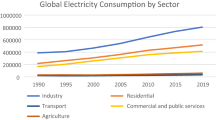Abstract
Due to the high impact that energy consumption by buildings has at global scale, energy-efficient buildings to reduce \(\mathrm{CO}_2\) emissions and energy consumption are needed. In this work we present a novel approach to energy saving in buildings through the identification of the relevant parameters and the application of Soft Computing techniques to generate predictive models of energy consumption in buildings. Using such models it is possible to define strategies for optimizing the day-to-day energy consumption of buildings. To verify the feasibility of this proposal, we apply our approach to a reference building for which we have contextual data from a complete year of monitoring. First, we characterize the building in terms of its contextual features and energy consumption, and then select the most appropriate techniques to generate the most accurate model of our reference building charged with estimating the energy consumption, given a concrete set of inputs. Finally, considering the energy usage profile of the building, we propose specific control actions and strategies to save energy.






Similar content being viewed by others
References
Agarwal Y, Balaji B, Gupta R, Lyles J, Wei M, Weng T (2010) Occupancy-driven energy management for smart building automation. In: Proceedings of the 2nd ACM workshop on embedded sensing systems for energy-efficiency in building. ACM, pp 1–6
Al-Homoud MS (2001) Computer-aided building energy analysis techniques. Build Environ 36(4):421–433
Berglund L (1977) Mathematical models for predicting thermal comfort response of building occupants. In: Ashrae Journal—American Society of Heating Refrigerating and Air-Conditioning Engineers, vol. 19(12). Amer Soc Heat Refrig Air-Conditioning Eng Inc 1791 Tullie Circle Ne, Atlanta, 30329:38-38
Berthold MR, Borgelt C, Höppner F, Klawonn F (2012) Guide to intelligent data analysis. Springer, London, Dordrecht, Heidelberg, New York
Breiman L (2001) Random forests. Mach Learn 45(1):5–32
Chen Z, Clements-Croome D, Hong J, Li H, Xu Q (2006) A multicriteria lifespan energy efficiency approach to intelligent building assessment. Energy Build 38(5):393–409
Clarke J, Cockroft J, Conner S, Hand J, Kelly N, Moore R, O’Brien T, Strachan P (2002) Simulation-assisted control in building energy management systems. Energy Build 34(9):933–940
Costa HRDN, La Neve A (2015) Study on application of a neuro-fuzzy models in air conditioning systems. Soft Comput 19:929–937. doi:10.1007/s00500-014-1431-5
Crawley DB, Lawrie LK, Winkelmann FC, Buhl WF, Huang YJ, Pedersen CO, Strand RK, Liesen RJ, Fisher DE, Witte MJ et al (2001) Energyplus: creating a new-generation building energy simulation program. Energy Build 33(4):319–331
Crawley DB, Hand JW, Kummert M, Griffith BT (2008) Contrasting the capabilities of building energy performance simulation programs. Build Environ 43(4):661–673
British Standards Institution (2007) Indoor environmental input parameters for design and assessment of energy performance of buildings addressing indoor air quality, thermal environment, lighting and acoustics. European committee for Standardization. Standardization, 2007
Friedman J, Hastie T, Tibshirani R (2000) Additive logistic regression: a statistical view of boosting (with discussion and a rejoinder by the authors). Ann Stat 28(2):337–407
Garg V, Bansal N (2000) Smart occupancy sensors to reduce energy consumption. Energy Build 32(1):81–87
Hagras H, Callaghan V, Colley M, Clarke G (2003) A hierarchical fuzzy-genetic multi-agent architecture for intelligent buildings online learning, adaptation and control. Inf Sci 150(1):33–57
Haykin SS (1999) Neural networks: a comprehensive foundation. Prentice Hall, Upper Saddle River, NJ
Lindberg R, Binamu A, Teikari M (2004) Five-year data of measured weather, energy consumption, and time-dependent temperature variations within different exterior wall structures. Energy Build 36(6):495–501
Luna F, Estébanez C, León C, Chaves-González JM, Nebro AJ, Aler R, Segura C, Vega-Rodríguez MA, Alba E, Valls JM et al (2011) Optimization algorithms for large-scale real-world instances of the frequency assignment problem. Soft Comput 15(5):975–990
Lu J, Sookoor T, Srinivasan V, Gao G, Holben B, Stankovic J, Field E, Whitehouse K (2010) The smart thermostat: using occupancy sensors to save energy in homes. In: Proceedings of the 8th ACM conference on embedded networked sensor systems. ACM, pp 211–224
McGregor A, Hall M, Lorier P, Brunskill J (2004) Flow clustering using machine learning techniques. In: Passive and active network measurement. Lecture notes in computer science, vol 3015. Springer, Berlin, Heidelberg, pp 205–214
Moreno M, Úbeda B, Skarmeta AF, Zamora MA (2014) How can we tackle energy efficiency in IoT based smart buildings? Sensors 14(6):9582–9614
Perera C, Zaslavsky A, Christen P, Georgakopoulos D (2014) Sensing as a service model for smart cities supported by internet of things. Trans Emerg Telecommun Technol 25(1):81–93
Perez-Lombard L, Ortiz J, Pout C (2008) A review on buildings energy consumption information. Energy Build 40(3):394–398
Petersen D, Steele J, Wilkerson J (2009) Wattbot: a residential electricity monitoring and feedback system. In: Proceedings of the 27th international conference extended abstracts on human factors in computing systems. ACM, pp 2847–2852
Scott J, Bernheim Brush A, Krumm J, Meyers B, Hazas M, Hodges S, Villar N (2011) Preheat: controlling home heating using occupancy prediction. In: Proceedings of the 13th international conference on ubiquitous computing. ACM, pp 281–290
Severini M, Squartini S, Piazza F (2013) Hybrid soft computing algorithmic framework for smart home energy management. Soft Comput 17(11):1983–2005
Voss K, Sartori I, Napolitano A, Geier S, Gonzalves H, Hall M, Heiselberg P, Widén J, Candanedo JA, Musall E, Karlsson B, Torcellini P (2010) Load matching and grid interaction of net zero energy buildings. In: Proceedings of EuroSun 2010, Graz, Austria, September 28–October 1, 2010
Zoha A, Gluhak A, Imran MA, Rajasegarar S (2012) Non-intrusive load monitoring approaches for disaggregated energy sensing: a survey. Sensors 12(12):16838–16866
Acknowledgments
This work has been sponsored by European Commission through the FP7-SMARTIE-609062 project.
Author information
Authors and Affiliations
Corresponding author
Additional information
Communicated by A. Jara, M. R. Ogiela, I. You and F.-Y. Leu.
Rights and permissions
About this article
Cite this article
Moreno, M.V., Dufour, L., Skarmeta, A.F. et al. Big data: the key to energy efficiency in smart buildings. Soft Comput 20, 1749–1762 (2016). https://doi.org/10.1007/s00500-015-1679-4
Published:
Issue Date:
DOI: https://doi.org/10.1007/s00500-015-1679-4




